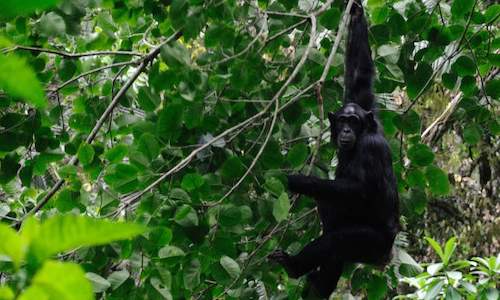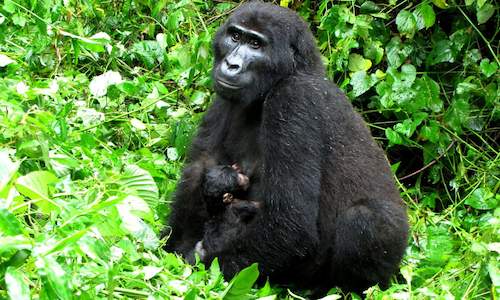
Queen Elizabeth National Park’s diverse ecosystems, big game and ten primate species make it Uganda’s most popular tourist destination. With a backdrop of the rugged Rwenzori Mountains, sparkling lakes joined by the Kazinga Channel, sculptured craters indenting the landscape, rolling hills covered in lush grass dotted with feeding buffalo and elephant the park’s many and varied vistas are a paradise for photographers and nature lovers alike.
History
The park area used to be primarily a grazing area for local pastoralists. When European explorers Stanley and Lugard came upon the area, they found it to be by and large unpopulated mainly due to cattle raiding and epidemics of rinderpest and smallpox. The few people that remained were concentrated around Lake George and Lake Edward and survived from fishing.
Thus allowing the game populations to move into the area and increase their numbers and for the vegetation to alter and become more varied. These events played an important role in determining the area as a protected area. To diminish unregulated hunting In 1906, the area north of Lake George was declared a game reserve.
By 1912 the whole of Lake George and Ishasha areas became restricted areas due to outbreaks of sleeping sickness. This forced agricultural and fishing communities to vacate the area leaving it largely abandoned. Sleeping sickness outbreaks continued up until the mid 1930’s, keeping human populations low and wildlife populations to increase.
The National Park Ordinance was passed in 1952 and the park was originally called Kazinga National Park, it became the Queen Elizabeth Park in 1954, to commemorate a visit by the Monarch, Queen Elizabeth II.
Equator
Monuments on either side of the road mark the exact spot where the equator cuts through Queen Elizabeth National Park.Kyambura Gorge
The Kyambura River over time, carved this deep gorge below the Kichwamba escarpment, depositing fertile soils and forming a thick ‘underground’ forest. This forested area is known for its resident chimpanzees. Some of which have become habituated to humans and can be tracked with Ugandan Wildlife Authority (UWA) guides. As you meander through the dense forest, you’ll find it is alive with chimpanzees, other primates and many bird species.Kyambura Wildlife Reserve
Just to the east of Kyambura Gorge are the alluring crater lakes a haven for water birds including lesser and greater flamingos and the great egret.Mweya and the Kazinga Channel
Mweya is perhaps the nucleus of the Queen Elizabeth National Park, here is the departure point for the Kazinga Channel launches, Visitors Centre, lodges and restaurants.
The Kazinga Channel is a long waterway, which connects Lake Edward and Lake George. Strewn along the channels banks are hippos, basking crocodiles, buffaloes and a multitude of water birds. Watch for large water lizards and bathing elephants as you cruise along on a boat safari, sit back and enjoy the passing scenery with your binoculars and camera at the ready.
Lake George
A prestigious papyrus swamp wetland, home to the shy sitatunga and shoebill.Explosion Craters
Remnants of Uganda’s volcanic past are 72 large round basins, producing a strange landscape. Take a scenic drive between Kabatoro Gate and Queen's Pavilion (27Kms) and witness the geological upheavals from a turbulent past across Africa’s Rift Valley.Kasenyi Plains
This ‘Out of Africa’ setting of savanna grasslands stretching into the far horizon covered in huge herds of Ugandan kob, lazing prides of lion, scuttling francolins and grey shadowy elephants is the essence of Kasenyi Plains. A photographers dream.Maramagambo Forest
In stark contrast to the open savanna of Kasenyi Plains is the thick Maramagambo Forest found in the centre of the park. A primate's playground, swinging through the branches you can glimpse chimpanzees, black and white colobus, red tailed and vervet monkeys. The forest is also a birders paradise, with sightings of the rare Forest Flycatcher, white-naped pigeon and the colourful Rwenzori turaco as well as many other forest species.Ishasha Sector
Down in the less visited southern part of the park you may have the opportunity to observe the unusual sight of lions, resting up in the branches of an acacia or fig tree in the Ishasha Sector. Herds of kob, buffalo and elephant abound in this area. Take some time to study the shores of Lake Edward and you may be rewarded with a rare shoebill sighting.
If you are on your way to see the Mountain Gorillas in Bwindi Impenetrable Forest National Park then Ishasha is a mere 70Kms away, a scenic and favourable route to use.
Queen Elizabeth National Park Activities
- Bat cave viewing room
- Game drives
- Trekking and nature walks
- Chimp tracking
- Mongoose research
- Lion tracking and monitoring
- Bird watching
- Katwe Salt Lake and bird watching tours
- Kikorongo Women Community - cultural performers and artcraft workshops
- Agro Tour Walk

 Enjoy a morning drive to Queen Elizabeth National Park and game viewing en route to Mweya. Also Spend time searching for chimpanzees and oth...
Enjoy a morning drive to Queen Elizabeth National Park and game viewing en route to Mweya. Also Spend time searching for chimpanzees and oth... Experience superb game viewing and track gorillas in this 14 Day Uganda Highlights Gorilla and Chimp tracking safari, where you will be acco...
Experience superb game viewing and track gorillas in this 14 Day Uganda Highlights Gorilla and Chimp tracking safari, where you will be acco...